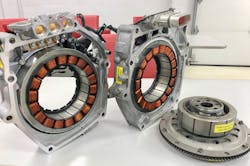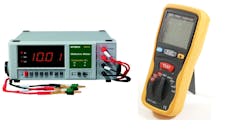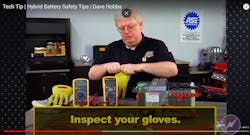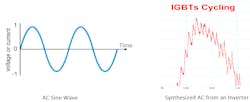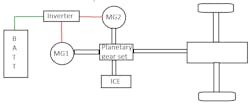When a gas guy goes hybrid
Content brought to you by Motor Age. To subscribe, click here.
What you Will Learn:
• Hybrids and BEVs are not that much different than the gasoline internal combustion engine driven vehicles we are accustomed to
• Proper diagnosis and repair mean having the right info, the proper tools and training
• The inverter turns DC volatge into AC voltage by synthesizing a simulated sine wave
It’s no secret that the automotive world we’ve grown with and learned so much about is rapidly changing. The ever so stringent emissions standards that govern how clean our vehicles propel themselves down the road continues to tighten their noose on a path towards zero-emissions output. In years past, so many have chosen to avoid verbalizing the word "hybrid" within the walls of the workshop. I believe those days are over. Like any other option we were faced with in years past, there is a choice to make. And as the adage goes, "If you can't stand the heat, get out of the kitchen.”
The point is we can run, but we can’t hide. Hybrids, plug-in hybrids and battery-electric vehicles (BEVs) are here to stay and are advancing as we speak. Don’t believe me? Just see what Motor Age’s Director of Training Pete Meier has to say about it in “The trend toward BEV,” also included in this issue. There is nothing to be afraid of. We all must grow and adapt to changing times. I’m going to show you how I learned to accommodate these changes before I was forced to.
The three-legged stool approach
I’ve mentioned this before and it’s worth stating again because it’s an analogy that made my career and success in this industry what it is today. Visualize an automotive technician perched upon this three-legged stool I speak of. The legs that keep he or she upright represent the three crucial elements that every successful technician needs:
- Fundamental knowledge
- Reliable service information
- Proper tooling
The first is what we have developed over our years of experience dealing with the basics and common components that make up virtually all systems in almost every vehicle. These are the things we should be intimately familiar with. Knowledge of how these devices function should become second nature to us, including understanding laws of physics such as Ohm's law, the operation of a DC motor and other inductive devices like relays and solenoids. These are found in almost everything we see daily; therefore, we should have them mastered. It's beneficial to not have to research their functionality each time we encounter them for evaluation.
Reliable service information includes the wiring diagram. This is the roadmap for the electric current to flow and allow the devices to operate. We all know the old mantra, "There is more than one way to skin a cat." Well, there are many ways to carry out the desired output. The wiring diagram allows us to see how any specific function is carried out on the specific vehicle we are faced with.
Equally as important as the wiring diagram is a solid description and theory of operation regarding the system you are working on. Just like the wiring diagram can be described as a road map, the description is specific instruction about how the system is intended to function. It also describes each of the components that make up the systems to carry out a specific function. These are both crucial to the successful and efficient diagnosis and repair of the vehicle.
Finally, we have proper tooling. Having the proper tools to evaluate the systems or components that make up these systems is necessary, as well. But understanding the limitations of the tools or tests you are performing is also a must. If we don't know what to anticipate from the outcome of a test, the data we gather is pointless.
Well, how does this relate to hybrids?
That three-legged stool approach that has served me so well applies to every diagnostic and service challenge we face. Yes, even hybrids. All three of the stool’s legs must be rigid and supportive to keep us efficient and accurate. Getting into hybrid diagnosis and repair means applying this three-legged stool approach. What this requires from us is a level of understanding that we may not already be familiar with, and that is OK. This is where training comes into play. We need the training to reinforce the strength of that fundamental knowledge stool leg.
Understand first that a hybrid is a vehicle that utilizes more than one source of propulsion. Some hybrids are configured as parallel hybrids, like that of Honda’s earlier systems (known as IMA or Integrated Motor Assist systems) where a three-phase AC-motor stator is confined within the bell housing of the engine/transmission. The motor’s rotor is attached to the crankshaft (where a torque convertor typically rests). The very small displacement internal combustion engine (ICE) will continue to run as the vehicle is propelled down the road, however, when necessary, the onboard ECUs will allow the IMA motor to produce torque. This allows the vehicle's small ICE to produce far fewer emissions, yet still require torque output to perform adequately. It’s referred to as a parallel hybrid because both propulsion systems (IMA and ICE) operate alongside one another. The IMA motor is also used to start the ICE.
The other configuration of the hybrid is one that is a bit more familiar and utilized. It is known as the series parallel hybrid. Probably one of the most well-known examples of this is the Toyota Prius. In this configuration, there is also an ICE (it serves multiple purposes and will be discussed shortly). However, the electrified propulsion system has two three-phase AC motor generators (or three, if all-wheel drive). They’re referred to as MGs. They serve to operate a bit differently (they, too, will be discussed shortly). In the heart of the hybrid propulsion system is a device called a compound gear unit. This device is a planetary gear set that allows for simultaneous or individualized operation of an MG and/or ICE. By holding one of the three planetary gear set major components still and driving another, the third component's output speed and direction are forced, enabling the planetary gear set to have many different modes of output. This is why it's referred to as a series parallel.
Both the electrified propulsion system and the ICE are connected by this compound drive unit planetary gear set to carry out the following functions:
- The ICE is connected to the planetary gear set’s carrier. This allows torque from the ICE to be carried to the transaxle.
- MG1 torque is sent to the ICE during start-up, by way of the sun gear as it is connected to MG1’s rotor. MG1 is also used to control engine gearing (when it is operated simultaneously with MG2) and provide charging to the hybrid battery pack, dependent upon operating conditions.
- MG2 is what propels the vehicle down the road. It is connected to the ring gear of the planetary gear set, which is part of the transaxle’s final drive.
- Regenerative braking is achieved when MG2 functions as a generator and charges the hybrid battery pack. MG2 is used as a generator to slow the vehicle and charge the HV battery pack.
AC to DC rectification; sure…but DC to AC synthesis?
If you’ve coupled what I had stated above with the picture of the planetary gear set, you can envision how a hybrid propulsion system can function mechanically. But we are not done yet. It still takes the appropriate training to gain that level of understanding regarding the electric and electronic controls. These allow those mechanical functions to happen.
Communication systems exist on all of today's vehicle platforms. It serves as a reduction in cost as well as weight. These virtual systems provide the same functionality as hard-wired systems, but much more efficiently. We should already be familiar with them and understand that they exist in hybrid vehicles, as well. This allows for the sharing of data from ECU to ECU and from system to system.
What you will find different is that the hybrid system operates at a much higher voltage level than the conventional charging system voltages we are accustomed to. With that being said, there is no need for a conventional charging system or an alternator. The typical system operating voltage we see will be derived from the high-voltage DC side (HV) of the vehicle. A device called a DC-DC converter takes the high voltage from the HV battery pack and steps it down to the 12-14v we are used to seeing.
Early on, I mentioned AC motor generators. They can't be supplied DC voltage and be expected to operate. So, how does the available DC voltage make its way to the MGs as “AC voltage?” It is through a device called an inverter that takes the high-voltage DC and synthesizes it to AC voltage.
Internal to the inverter are very fast operating electronic switching devices called insulated gate bipolar transistors (IGBTs). When operating, they allow current to flow and when at rest, current flow ceases. The takeaway is that they operate so swiftly that the current amplitude can be controlled by controlling the frequency in which they operate. This effectively synthesizes the AC waveform using DC voltage.
The inverter also contains high-voltage diodes. They serve as a way to rectify the AC voltage from the MGs, back to DC (like a conventional alternator) so it can replenish the HV battery packs and allow the functionality of the components found on the conventional system voltage side.
Proper tooling
As with any other system we've encountered in the past, proper tools and familiarity with them are what it takes to get the job done right the first time. First and foremost is a need for safety. When dealing with high-voltage systems, we could see voltages near 40v and upwards of nearly 600v. It takes very little amperage to really injure or even kill you. Safety is of the utmost importance. Be sure to always follow the recommended service procedures and to always take the prescribed necessary precautions when working on or around HV vehicles and their components.
Proper precautions mean utilizing the appropriately rated personal protection equipment (PPE). This includes insulated gloves rated at Class-0 or up to 1000vAC. These gloves should be field inspected and tested before and after each use and are required to be certified (sent out for evaluation) every six months. It’s always wise to ensure your hands are dry by using glove dust and also covering the gloves for protection, with the use of leather gloves over top of the PPE. This will ensure your PPE is protected from damage and you are properly insulated from electrical shock. Insulated hand tools are also recommended to further protect you and those around you.
Venturing into hybrid vehicle diagnosis and repair will certainly put you in front of some tooling you may not be familiar with. One of these devices is a megaohm meter (commonly known as a megger). This device is like an ohmmeter on steroids. It’s used to determine a breakdown in HV component insulation. It functions by driving very high voltage (500v or more) into a component and measures resistance accurately in even billions of ohms. Its operation is designed to detect a short-circuit or continuity between an HV component and chassis ground.
Another device that may not ring any bells is the milliohm meter. This functions on the exact opposite end of the spectrum. Its operation is designed to detect even very minor shorts between the three stator windings of an MG.
Training and certification
Finally, where can one go to get the proper training to be a qualified hybrid/electric vehicle technician? There are several reliable sources of training information and ways to become a certified technician. For instance, CarQuest Technical Institute is a great source of technical information about hybrid/electric vehicles from a general perspective. However, you will want to do your research and determine what is best for you and your shop when it comes to certification. There are several reputable sources to gain certification.
We at Motor Age support and encourage ASE certification and provide study guides to serve as cliff-notes and to aid and prepare the technician for certification. ASE certification will not only increase the appearance of professionalism for you and your, shop but also instill confidence in your hybrid/electric vehicle customers.
So as can be seen above, I'm not telling you anything I haven't stated many times in the past. Going "hybrid" is more of a mindset than a skillset. Acquire the proper knowledge, invest in the appropriate tooling and provide yourself with adequate service information so you not only understand how the hybrid propulsion (and supportive systems) functions in general, but are familiar with the vehicle you’re are addressing in your bay currently.
